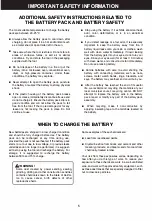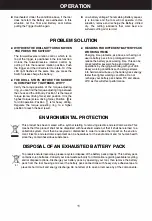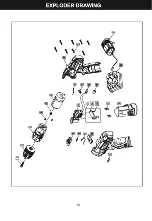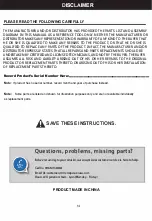
OPERATION
5. CHUCK ADJUSTMENT (SEE FIG. 6)
To open the chuck (1) jaws rotate the front section of
the chuck. Insert the drill bit between the chuck jaws
and rotate the front section in the opposite direction.
Ensure the drill bit is in the center of the chuck jaws.
Finally, firmly rotate the front chuck section in the
opposite directions. Your drill bit is now clamped in
the chuck.
6. TORQUE ADJUSTMENT (SEE FIG. 7)
(Screw driving force of your drill driver)
The torque is adjusted by rotating the torque
adjustment ring (2). The torque is greater when the
torque adjustment ring is set on a higher setting. The
torque is less when the torque adjustment ring is set on
a lower setting. Make the setting as follows:
1 -4
For driving small screws
5-9
For driving screws into soft material
10-14
For driving screws into soft and hard material
15-18
For driving screws into hard wood
�
For heavy drilling
'if
For hammer drill
10
7. USING THE LED LIGHT (SEE FIG. 8)
The
LED
light (9) allows you to keep a clear view under
less illuminated circumstances. To turn on the light
simply press the on/off switch. When you release the
on/off switch, the light will go out.
FIG.8
8. DRILLING
When drilling into a hard smooth surface, use a center
punch to mark the desired hole location. This will
prevent the drill bit from slipping off center as the hole
is started. Hold the tool firmly and place the tip of the
bit at the point to be drilled. Depress the switch trigger
to start the tool. Move the drill bit into the workpiece,
applying only enough pressure to keep the bit
rotating. Do not force or apply side pressure to
elongate a hole.
A. Drilling In wood
Holes in wood can be made with the same twist drill
bits used for metal or with spade bits. These bits
should be sharp and should be pulled out frequently
when drilling to clear chips from the flutes.
B. Drilling In Metal
Use a cutting lubricant when drilling metals. The
exceptions are cast iron and brass which should be
drilled dry. The cutting lubricants that work best are
sulfured cutting oil or lard oil.
9. TOOL PROTECTION SYSTEM
The tool will automatically stop during operation if
the tool and/or battery are placed under one of the
following conditions:
■ Overloaded: The tool is operated in a manner that
causes it to draw an abnormally high current. In this
situation, release the Trigger Switch on the tool and
stop the application that caused the tool to
become overloaded. Then pull the Trigger Switch
again to restart.
Summary of Contents for 47519
Page 13: ...12 ...

































